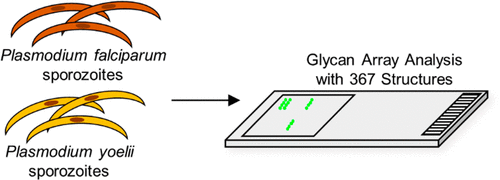当前位置:
X-MOL 学术
›
ACS Infect. Dis.
›
论文详情
Our official English website, www.x-mol.net, welcomes your
feedback! (Note: you will need to create a separate account there.)
Identification of the Glycan Binding Profile of Human and Rodent Plasmodium Sporozoites
ACS Infectious Diseases ( IF 4.0 ) Pub Date : 2021-06-25 , DOI: 10.1021/acsinfecdis.1c00084 Jessica Poole 1 , Lauren E Hartley-Tassell 1 , Christopher J Day 1 , Danielle I Stanisic 1 , Penny L Groves 2 , Sumana Chakravarty 3 , B Kim Lee Sim 3 , Stephen L Hoffman 3 , Joe Tiralongo 1 , Nicolai Bovin 4 , Denise L Doolan 5 , Michael P Jennings 1
ACS Infectious Diseases ( IF 4.0 ) Pub Date : 2021-06-25 , DOI: 10.1021/acsinfecdis.1c00084 Jessica Poole 1 , Lauren E Hartley-Tassell 1 , Christopher J Day 1 , Danielle I Stanisic 1 , Penny L Groves 2 , Sumana Chakravarty 3 , B Kim Lee Sim 3 , Stephen L Hoffman 3 , Joe Tiralongo 1 , Nicolai Bovin 4 , Denise L Doolan 5 , Michael P Jennings 1
Affiliation

|
The transmission of Plasmodium spp. sporozoites to the mammalian host is the first step in the initiation of the mosquito-borne disease known as malaria. The exact route of transmission from the bloodstream to the liver is still not clearly elucidated, and identification of the host glycan structures bound by the sporozoites may inform as to which host cells are involved. Here, we provide a comprehensive analysis of the glycan structures that sporozoites from the human pathogen, P. falciparum, and the rodent pathogen, P. yoelii, recognize and bind. Glycan array analysis was used to profile the glycans bound by the sporozoites, and the binding affinities of these sporozoite-glycan interactions were then determined by surface plasmon resonance. Data showed that the different Plasmodium spp. bind different classes of glycans. P. falciparum was observed to bind to glycans with terminal N-acetylgalactosamine (GalNAc) or Galactose (Gal) linked to a GalNAc, and the highest-affinity observed was with the GalNAc monosaccharide (12.5 nM). P. yoelii bound glycosaminoglycans, mannosyl glycans, Gal linked to N-acetylglucosamine structures, and the αGal epitope. The highest-affinity interaction for P. yoelii was with the αGal epitope (31.4 nM). This is the first study to identify the key host glycan structures recognized by human and rodent Plasmodium spp. sporozoites. An understanding of how Plasmodium sporozoites interact with the specific glycan structures identified here may provide further insight into this infectious disease that could help direct the design of an effective therapeutic.
中文翻译:

鉴定人和啮齿动物疟原虫子孢子的聚糖结合谱
疟原虫的传播。子孢子进入哺乳动物宿主是引发称为疟疾的蚊媒疾病的第一步。从血流到肝脏的确切传播途径仍未清楚阐明,子孢子结合的宿主聚糖结构的鉴定可能会告知涉及哪些宿主细胞。在这里,我们对来自人类病原体恶性疟原虫和啮齿动物病原体约氏疟原虫子孢子的聚糖结构进行了全面分析,识别并绑定。聚糖阵列分析用于分析子孢子结合的聚糖,然后通过表面等离子体共振确定这些子孢子-聚糖相互作用的结合亲和力。数据显示,不同的疟原虫属。结合不同种类的聚糖。观察到恶性疟原虫与末端N-乙酰半乳糖胺 (GalNAc) 或半乳糖 (Gal) 的聚糖结合,观察到的最高亲和力是与 GalNAc 单糖 (12.5 nM)。约氏疟原虫结合糖胺聚糖、甘露糖基聚糖、与N-乙酰氨基葡糖结构相连的 Gal和 αGal 表位。P. yoelii的最高亲和力相互作用与 αGal 表位 (31.4 nM)。这是第一项确定人类和啮齿动物疟原虫识别的关键宿主聚糖结构的研究。子孢子。了解疟原虫子孢子如何与此处鉴定的特定聚糖结构相互作用可能会提供对这种传染病的进一步了解,从而有助于指导有效治疗方法的设计。
更新日期:2021-08-13
中文翻译:

鉴定人和啮齿动物疟原虫子孢子的聚糖结合谱
疟原虫的传播。子孢子进入哺乳动物宿主是引发称为疟疾的蚊媒疾病的第一步。从血流到肝脏的确切传播途径仍未清楚阐明,子孢子结合的宿主聚糖结构的鉴定可能会告知涉及哪些宿主细胞。在这里,我们对来自人类病原体恶性疟原虫和啮齿动物病原体约氏疟原虫子孢子的聚糖结构进行了全面分析,识别并绑定。聚糖阵列分析用于分析子孢子结合的聚糖,然后通过表面等离子体共振确定这些子孢子-聚糖相互作用的结合亲和力。数据显示,不同的疟原虫属。结合不同种类的聚糖。观察到恶性疟原虫与末端N-乙酰半乳糖胺 (GalNAc) 或半乳糖 (Gal) 的聚糖结合,观察到的最高亲和力是与 GalNAc 单糖 (12.5 nM)。约氏疟原虫结合糖胺聚糖、甘露糖基聚糖、与N-乙酰氨基葡糖结构相连的 Gal和 αGal 表位。P. yoelii的最高亲和力相互作用与 αGal 表位 (31.4 nM)。这是第一项确定人类和啮齿动物疟原虫识别的关键宿主聚糖结构的研究。子孢子。了解疟原虫子孢子如何与此处鉴定的特定聚糖结构相互作用可能会提供对这种传染病的进一步了解,从而有助于指导有效治疗方法的设计。











































 京公网安备 11010802027423号
京公网安备 11010802027423号